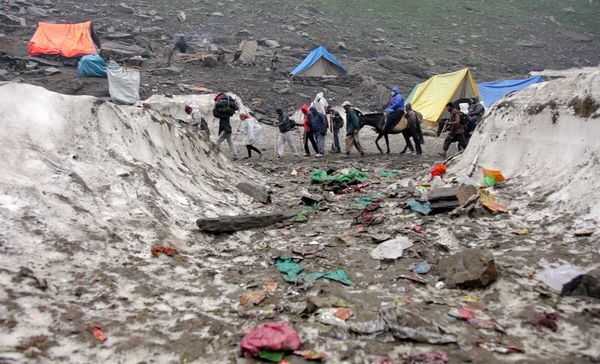As yet another example of the kind of wide-spread impacts pilgrimage can have, an article about the melting of a glacier as a result of Hindu pilgrims in the Himalayas. You can read more about it in the National Geographic article, "Massive Hindu Pilgrimage Melting Sacred Glacier."
|
This week in class, we'll be thinking about what makes a pilgrimage, something that we can call "pilgrimage." First, we'll think about what makes up the defining characteristics of a pilgrimage based on our own intuition: is pilgrimage, like the famous Supreme Court Justice's pronouncement on pornography, just something that you "know it when you see it"? Or can we have a set in criteria in mind when approaching the phenomenon of pilgrimage, as earlier scholars have attempted to do?
In today's reading, Plate notes that "Some readers may balk at the idea that these [mass pilgrimages to atomic testing sites, Graceland, etc.] are ‘‘real pilgrimages,’’suggesting it is all just ‘‘tourism,’’ but that is to elide some crucial similarities that bear fleshing out" (2009: 262). Where should the line be drawn? Perhaps one question we should be asking is, "What kind of travel is NOT pilgrimage?" And for the purposes of this class, it's interesting to think about the role of the place, the destination, in the definition of the journey and the experience as a whole: how does that impact its designation as a pilgrimage destination? I'm looking forward to hearing what you might think! Welcome! For the first day of class, we'll just briefly go through the premise for the class - what we want to accomplish, and what it's going to involve. As I’ve explained at the beginning of the syllabus, “This course will investigate the mechanisms by which people decided to undertake pilgrimage” – seems pretty straightforward, right? We’ll look at pilgrimages from around the world, from ancient Incan pilgrimage in what is now Peru to the Kumbh Mela in modern India. We will also approach pilgrimage and travel from a wide chronological scope, from Greek healing pilgrimages taking place almost 3000 years ago, to modern Muslim pilgrimages to Mecca. While the class is titled "Pilgrimage and Travel in the Ancient World," many modern pilgrimages have their roots in ancient pilgrimages, and as much as those ancient origins inform the practices and beliefs of today’s pilgrims, our modern practices color our understanding of the past. So, by looking at both modern and ancient case studies, I want to accomplish 2 things: one, a better understanding of the ancient world; and second - and arguably more important - a better understanding of the world we live in today.
Underlying pilgrimage and travel is the notion that by looking at how and why people moved through the worlds they live in, we can outline some of the religious, political, economic, and social contexts they have to deal with. Pilgrimage sites were EVERYWHERE. For example, it has been said that: "The most revealing map of Europe [in the early Middle Ages] would be a map, not of political or commercial capitals, but of the constellation of sanctuaries, the points of material contact with the unseen world" (R.W. Southern, The Making of the Middle Ages, 1953: 133). This is particularly true, perhaps, for Europe and the Mediterranean in its early centuries of dominance, but many of those places were in turn important pre-Christian sacred places – the very word ‘pagan’ is a Christian invention, which has important connotations we need to consider when we study that world – as well as Muslim across a large part of the Mediterranean world. The point is, pilgrimage travel was not just a religious undertaking: it involved money and means to travel, permission to travel, places to travel to, knowledge of those places and how to get there, and a number of other factors that we will address over the course of the term: all lying under the broad learning objectives outlined in the syllabus as motivations, context, destinations, and infrastructure. An archaeology of ancient roads and communication systems is an exercise in filling in the gaps and learning to synthesize data that we do have, an exercise that is important and useful not only in archaeology but in any undertaking; what I want is to work through this class by applying critical thinking through the lens of movement, travel, and pilgrimage - and, in the end, that is going to be something you can take away from archaeology, from history, the study of movement, and apply to real world experience. |
ArchivesCategories |


 RSS Feed
RSS Feed
